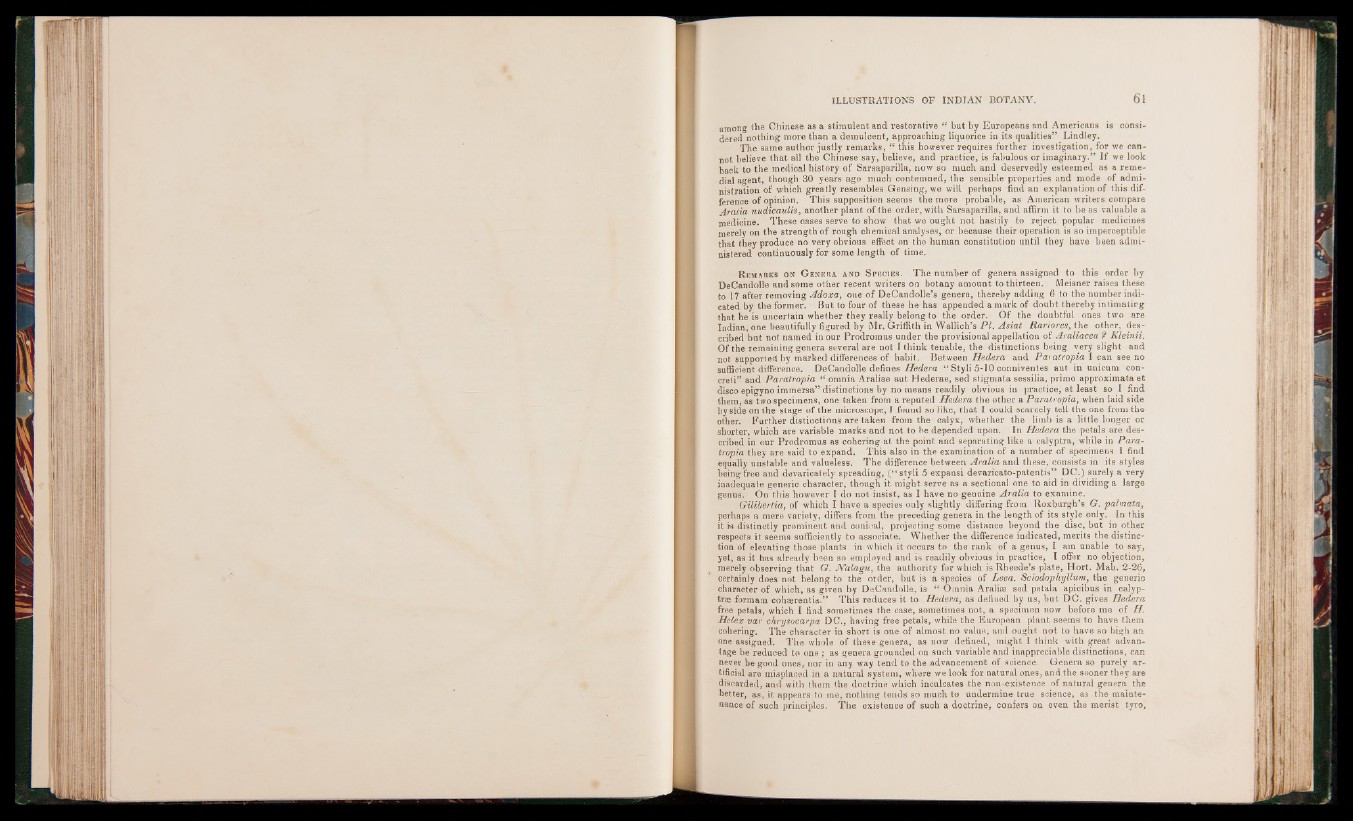
among the Chinese as a stimulentand restorative " but by Europeans and Americans is considered
nothing more than a demulcent, approaching liquorice in its qualities” Lindley.
The same author justly remarks, “ this however requires further investigation, for we cannot
believe that all the Chinese say, believe, and practice, is fabulous or imaginary.” If we look
back to the medical history of Sarsaparilla, now so much and deservedly esteemed as a remedial
agent, though 30 years ago much contemned, the sensible properties and mode of administration
of which greatly resembles Gensing, we will perhaps find an explanation of this difference
of opinion. This supposition seems the more probable, as American writers compare
Aralia nudicaulis, another plant of the order, with Sarsaparilla, and affirm it to be as valuable a
medicine. These cases serve to show that we ought not hastily to reject, popular medicines
merely on the strength of rough chemical analyses, or because their operation is so imperceptible
that they produce no very obvious effect on the human constitution until they have been administered
continuously for some length of time.
R emarks on G enera and S pecies. The number of genera assigned to this order by
DeCandolle and some other recent writers on botany amount to thirteen. Meisner raises these
to 17 after removing Adoxa, one of DeCandolle’s genera, thereby adding 6 to the number indicated
by the former. But to four of these he has appended a mark of doubt thereby intimating
that he is uncertain whether they really belong to the order. Of the doubtful ones two are
Indian, one beautifully figured by Mr. Griffith in Wallich’s PI. Asiat Rariores, the other, described
but not named in our Prodromus under the provisional appellation of Araliacea ? Kleinii.
Of the remaining genera several are not I think tenable, the distinctions being very slight and
not supported by marked differences of habit. Between Hedera and Paratropia I can see no
sufficient difference. DeCandolle defines Hedera “ Styli 5-10 conniventes aut in unicum concrete’
and Paratropia “ omnia Araliae aut Hederae, sed stigmata sessilia, primo approximata et
disco epigyno immersa” distinctions by no means readily obvious in practice, at least so I find
them, as two specimens, one taken from a reputed Hedera the other a Paratropia, when laid side
by side on the stage of the microscope, I found so like, that I could scarcely tell the one from the
other. Further distinctions are taken from the calyx, whether the limb is a little longer or
shorter, which are variable marks and not to he depended upon. In Hedera the petals are described
in our Prodromus as cohering at the point and separating like a calyptra, while in Paratropia
they are said to expand. This also in the examination of a number of specimens I find
equally unstable and valueless. The difference between Aralia and these, consists in its styles
being free and devaricately spreading, (“ styli 5 expansi devaricato-patentis” DC.) surely a very
inadequate generic character, though it might serve as a sectional one to aid in dividing a large
genus. On this however I do not insist, as I have no genuine Aralia to examine.
Gilibertia, of which I have a species only slightly differing from Roxburgh’s G. palmata,
perhaps a mere variety, differs from the preceding genera in the length of its style only. In this
it is distinctly prominent and conical, projecting some distance beyond the disc, but in other
respects it seems sufficiently to associate. Whether the difference indicated, merits the distinction
of elevating those plants in which it occurs to the rank of a genus, I am unable to say,
yet, as it has already been so employed and is readily obvious in practice, l offer no objection,
merely observing that G. Nalagu, the authority for which is Rheede’s plate, Hort. Mab. 2-26,
certainly does not belong to the order, but is a species of Leea. Sciodophyllum, the generic
character of which, as given by DeCandolle, is “ Omnia Araliae sed petaia apicibus in calyp-
trse formam cohaerentia.” This reduces it to Hedera, as defined by us, but DC. gives Hedera
free petals, which I find sometimes the case, sometimes not, a specimen now before me of H.
Hclex var chrysocarpa DC., having free petals, while the European plant seems to have them
cohering. The character in short is one of almost no value, and ought not to have so high an
one assigned. The whole of these genera, as now defined, might I think with great advantage
be reduced to one ; as genera grounded on such variable and inappreciable distinctions, can
never be good ones, nor in any way tend to the advancement of science. Genera so purely artificial
are misplaced in a natural system, where we look for natural ones, and the sooner they are
discarded, and with them the doctrine which inculcates the non-existence of natural genera the
better, as, it appears to me, nothing tends so much to undermine true science, as the maintenance
of such principles. The existence of such a doctrine, confers on even the merist tyro,